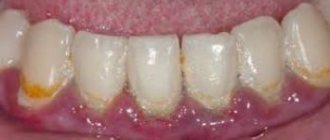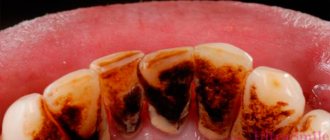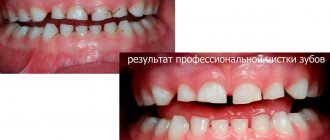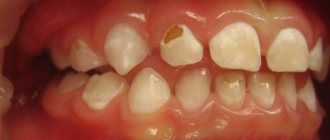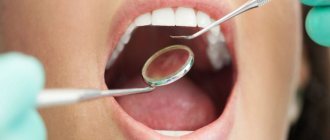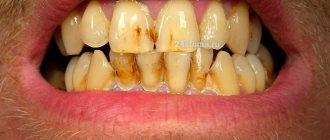In most cases, dental plaque is the cause of insufficient oral hygiene. But it also happens that people who are very sensitive to hygiene issues develop black plaque on their teeth.
The reasons for its appearance in adults and children differ : if in the former it is a consequence of drinking large amounts of tea and coffee, as well as smoking, then in the latter it may be associated with the activity of certain bacteria, the use of mouthwashes and the use of chewable vitamins.
Types of plaque
Plaque on teeth is divided into two large groups:
- the occurrence of which is associated with external contamination of the tooth;
- appearing due to the deposition of pigments.
If oral hygiene is not maintained, plaque may appear on the teeth:
- soft microbial;
- mineralized;
- hard, often called tartar.
If everything is in order with hygiene, then black plaque is a consequence of:
- regular consumption of tea, coffee and nicotine;
- use of medications with high iron content;
- vital activity of chromogenic bacteria;
- use of certain types of rinses and antiseptics.
Consequences of long-term exposure to plaque on enamel
Perhaps some people are in no hurry to part with plaque because they consider it a purely cosmetic defect that does not affect health. The following facts will help you make sure that this is not the case:
- the activity of bacteria leads to the destruction of enamel;
- thinning of the enamel increases sensitivity;
- plaque gives impetus to the development of caries;
- the appearance of plaque can provoke any diseases of the oral cavity: periodontitis, gingivitis, etc.
As a result, because of such a “trifling” problem, you can get a whole bunch of oral diseases: bleeding gums, caries and, of course, halitosis.
- Dark plaque on a child's teeth
What is halitosis?
Important! Another bad news is that sometimes you will only see plaque, when the problem itself will be under the gum.
Bacterial plaque on teeth: causes
Soft or, as it is also called, bacterial plaque has a soft consistency, so it is easy to get rid of it with the help of an ordinary toothbrush. The main place of its accumulation is the neck of the teeth.
Harder plaque that cannot be removed with a brush is called tartar. It occurs during the mineralization of soft plaque with phosphorus and calcium salts present in saliva.
Why does plaque form?
There are constantly a huge number of bacteria in the mouth, which, firstly , multiply, and secondly , leave behind waste products. Even if you brush your teeth regularly, plaque cannot be avoided: within 6 hours after thorough brushing, you can easily notice, without resorting to the use of specialized equipment, a bacterial mass on the surface of the tooth enamel. A surge in microbial activity is observed immediately after eating: leftover food in the mouth forces bacteria to begin intensive processing.
At the same time, even small pieces of food that are invisible to the human eye are enough for microorganisms: they can feed on a film consisting of carbohydrates and proteins that invariably remains on the surface of the teeth after eating, and on food debris that gets into the spaces between the teeth. In this regard, it is imperative to brush your teeth for 15 minutes after each meal, since the mass of bacterial plaque can increase several times in volume in 1-2 hours. Plaque accumulates especially intensely on the necks of teeth in people who like to snack on a bun or something sweet between main meals.
Almost immediately after the soft plaque appears, the process of mineralization begins, as a result of which it gradually hardens. The period of primary mineralization (i.e., when the plaque, in simple terms, “sets” but still remains loose) is 10-15 hours. When the plaque finally hardens, its surface becomes ideal for the formation of deposits.
If the tooth has darkened
If one tooth has darkened and this is not a superficial plaque, but a change in the color of the tooth enamel, this means that we are talking about the death of the dental nerve and damage to the pulp. Perhaps the nerve was killed or removed during dental treatment, or the patient was in no hurry to see a doctor during an acute inflammatory process that led to the death of the nerve. Be that as it may, if a tooth is blackened from the inside, it means that only intra-canal whitening, installation of a crown or veneer will help it. In this case, the dentist must first find out why the tooth turned black and rule out the inflammatory process.
As a rule, an experienced specialist, when treating a tooth with nerve removal, knows that it will change color and immediately advises the patient to think about installing a crown or veneer. Therefore, if you don’t know exactly why your tooth turns black, remember if your doctor warned you about the possibility of such consequences.
Sometimes the reason a patient goes to the dentist is that the tooth has turned black under the filling. In this case, the cause of the tooth discoloration is most likely due to poor quality treatment. In particular, the filling may turn black if blood gets into it during installation - for example, because the doctor injured the gum. Also, a tooth under a filling may turn black if the dentist has not completely removed the damaged tooth and the carious process continues under the filling. In this case, the filling will have to be removed and a new one installed. This is a good reason to think about the professionalism of the doctor who performed the dental treatment.
In any case, the first thing to do if a tooth has turned black is to contact a reliable, highly qualified dentist.
Pigmented dark plaque on teeth
The main reason for the appearance of such plaque in adults is smoking, drinking coffee and tea. Maintaining hygiene guarantees the absence of bacterial plaque and tartar, but if you neglect it, black plaque will not take long to appear. Pigments adhere very well to enamel covered with bacterial plaque formed as a result of infrequent brushing of teeth.
Types of pigment plaque include:
- brown coating that occurs from regular consumption of tea and coffee in large quantities;
- accumulation of nicotine deposits;
- darkening of the enamel as a result of taking medications containing iron;
- proliferation of bacteria that form dyes (they are called chromogenic);
- change in enamel color after using antibiotics;
- blackening due to diseases of internal organs.
If plaque is caused by bacterial factors, then regular thorough brushing of teeth, the use of rinses and floss reduce the likelihood of its occurrence to a minimum. However, if the reason for the appearance of plaque lies in the influence of dyes, maintaining hygiene to prevent it will not help.
Black plaque on children's teeth , the causes of which are associated with the activity of chromogenic anaerobic bacteria, appears in the form of spots localized in the neck area. Actinomycete bacteria produce hydrogen sulfite, which reacts with iron (found in saliva and red blood cells). As a result, a form of black iron that cannot be cleaned off with a regular brush is deposited on the surface of the teeth. Chromogenic coloration can also be orange, green and brown.
Black plaque on a child’s teeth can also form for other reasons . It appears due to:
- the use of antiseptics that contain chlorhexidine, benzaclonium chloride, as well as essential oils (the latter are found in the popular Listerine product);
- consumption of foods rich in iron, as well as vitamins with a high content of iron.
Smoking cigarettes and cigars
Black-brown plaque, tightly adjacent to the necks of the teeth on the inside of the row, appears as a result of smoking. In the process of smoking a cigarette or cigar, resins and carcinogens are deposited on the enamel, which contribute to pigmentation. This bad habit provokes the emergence of many dangerous problems and dental diseases. Which ones? You can read more about this in the feature article on our website.
Do not forget that by consuming cigarettes, you expose the enamel to strong temperature changes, due to which it cracks, and any pigment from food and drinks gets into the cracks much more easily.
Notice
: Undefined variable: post_id in
/home/c/ch75405/public_html/wp-content/themes/UltraSmile/single-item.php
on line
45 Notice
: Undefined variable: full in
/home/c/ch75405/public_html/wp-content /themes/UltraSmile/single-item.php
on line
46
Rate this article:
( 1 ratings, average: 5.00 out of 5)
plaque
- Evteev S.S., Lebedeva S.N., Kharitonova T.L. Etiological factors of dental discoloration // Bulletin of medical Internet conferences. – 2022.
Expert “In order to prevent plaque from spoiling your smile, you need to undergo preventive examinations at the dentist and professional hygiene twice a year. It must be remembered that plaque can form not only on natural teeth, but also on artificial materials used for restorations. Restored teeth also require careful hygienic care.” Dentist-therapist Elina Ruslanovna Dzagurova
Consulting specialist
Dzagurova Elina Ruslanovna
Doctor rating: 9.5 out of 10 (2) Specialization: Dentist-therapist Experience: 11 years
How to remove plaque from teeth on your own
Many people do not like to visit the dentist again, especially when it comes to removing plaque, which does not cause much inconvenience. The reasons for this are clear: lack of free time and reluctance to pay for the procedure.
You can try to remove plaque from your teeth at home, but this will only work if there are no subgingival deposits and the plaque layer is thin.
The first method involves using a special toothpaste to remove plaque with abrasive substances. The label of such pastes must indicate the RDA indicator, indicating the degree of abrasiveness. In pastes that eliminate plaque, its value should exceed 100. But such pastes cannot be used on an ongoing basis. If the paste contains pyrophosphates, then it can help get rid of tartar, since they have the ability to dissolve its matrix.
The most effective of these pastes are:
- President White Plus. The abrasiveness index is 200 units; in addition, the composition contains silicon dioxide, which has abrasive and polishing properties. You should not use the paste more than once a week.
- Lacalut White. According to the abrasiveness index (RDA=120), it is more gentle than the previous sample. The composition contains pyrophosphates, which make the plaque loose.
The second method is to use a special toothbrush, which allows you to remove plaque yourself. Recommended use:
Dental ways to get rid of the problem
Professional plaque cleaning is carried out using various methods:
- Ultrasonic whitening. Cleaned using an ultrasonic device. This method is the most popular and universal for those who want to remove plaque. Ultrasonic devices called scalers are used for this procedure. The principle of operation is to remove dental plaque of varying severity, removing the most massive and hard dental deposits located above and below the gum. After cleaning the plaque with ultrasound, the teeth are polished using polishing brushes and pastes. This method can also be used in children's practice.
- Air Flow cleaning. It is a special system that allows you to combat plaque using a water-air flow with an abrasive and polishing substance. The technology allows you to effectively clean not only the surface of the teeth, but also interdental pockets, subgingival plaque and biofilm with bacteria. The procedure is absolutely painless and is recommended as a preventive measure for many dental pathologies.
- Laser whitening. This painless and enamel-preserving procedure helps get rid of black spots on teeth. When cleaning with a laser, the gums are not injured and there is no bleeding. The therapeutic effect is high and can last for more than five years.
Important! Only a dental hygienist can select the most suitable method for cleaning teeth from black plaque. At the same time, he takes into account the clinical picture of the oral cavity and the age of the patient.
Air Flow Cleaning Laser Whitening Ultrasonic Whitening
Plaque on a child’s teeth: treatment
Removing bacterial and chromogenic plaque in a child will be no different from a similar procedure recommended for an adult: ultrasonic cleaning and AirFlow are used in the same way.
However, chromogenic staining of teeth may return over time. The only possible solution to the problem is regular professional cleaning by a dentist. To make visits to the dentist as rare as possible, your child should be taught to use an electric toothbrush, the pulsating circular movements of the head of which perfectly break up plaque.
Accelerated formation of deposits is promoted by blood in the oral cavity, so the child’s gingivitis must be treated. The use of chlorhexidine and antiseptics based on it should be abandoned.
Localization options
Black plaque can be located on various parts of the tooth surface.
Depending on the location and anatomical and topographical areas of fixation, it can be:
- Supragingival. Located on the exposed surface of the tooth.
- Subgingival. It is formed in the area of the lower edge of the periodontium in the gingival groove or in the gingival pocket along the rim of the tooth.
- Dentogingival. Localized on smooth tooth surfaces.
- Proximal. Located on the contact areas of tooth enamel.
- Epithelially attached. Fixed to the periodontal epithelium.
- Subgingival-tooth-attached. Affects the entire surface of the dentition.
The main location of black plaque is the spaces between the teeth, their inner surface and the area near the gums.
Black plaque in a child
Black plaque in an adult
Removing black plaque with ultrasound
Ultrasound is best used to remove black plaque if it has already caused the formation of tartar. Teeth are cleaned using a drill with a specific attachment.
Plaque is removed according to this scheme.
- A scaler attachment is installed on the equipment.
- A saliva ejector is placed in the mouth.
- The teeth are coated with an abrasive paste.
- The nozzle rotates at an ultrasonic frequency, and at the same time a thin stream of water flows onto the surface of the tooth enamel.
You can remove black plaque with ultrasound from a doctor
The advantage of this method is that it helps remove soft and hard plaque, as well as tartar. The downside is the lack of therapeutic effects. The procedure is usually carried out once every six months.
Important! If the pathogenic microflora is very active, then a fresh black formation can become denser in 3-4 months. So after 2 or 3 months, the teeth will again begin to be covered with dark plaque.
Contraindications to ultrasonic cleaning:
- infectious hepatitis;
- enamel erosion, foci of demineralization;
- use of pacemakers;
- HIV infection;
- tuberculosis;
- a number of heart diseases;
- dental implantation with titanium pins;
- diabetes;
- malocclusion in children;
- baby teeth.
There are contraindications to such cleaning
Eliminating black plaque with folk remedies
The use of traditional methods for removing black plaque is based on regulating the activity of pathogenic microflora in the mouth. Therefore, many home remedies work due to their antimicrobial and anti-inflammatory properties.
You can also remove plaque with the help of folk remedies.
Types of Home Remedies
Such remedies can only help in untreated cases.
A product made from activated carbon and 3% hydrogen peroxide . A paste is made from these ingredients, then rubbed over the surface of the tooth enamel using a toothbrush. Hydrogen peroxide serves as a bleaching agent, and charcoal acts as an abrasive. The product must be used very carefully, otherwise you can injure tooth enamel.
A decoction of bean husks and burdock root. The components are taken dry in a 1:1 ratio. A tablespoon of the mixture is boiled for 5 minutes, and then left for about 20 hours. Every time after eating, you need to rinse your mouth with 1 tbsp. l. decoction You also need to consume 2 tbsp. l. inside. Treatment is carried out for 2 weeks.
Use a variety of herbs and plants
Black radish remedy . A hole is made in the vegetable, honey is added inside, then left in the refrigerator for a day. After meals (3 times a day), fill a tablespoon with honey and radish shavings and chew well. The product inhibits the activity of bacteria, their waste products are removed. A side effect of the drug is the dilution of bronchial secretions and stimulation of salivation. You need to undergo treatment for six months.
Honey water and soda . One tablespoon of honey is diluted in 100 ml of water. You should rinse your mouth with this solution every time after eating. 1-2 rinses are carried out at a time. Along with this, you need to clean your teeth once a week with a paste containing soda. Honey is used as a natural antifungal agent, and baking soda acts as an abrasive and antiseptic.
You can use soda, honey
